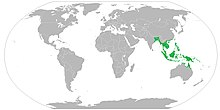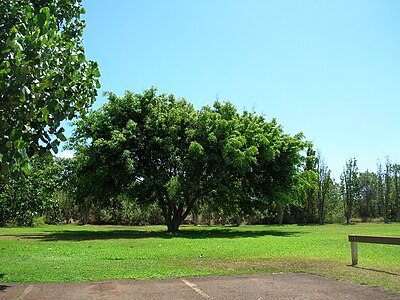Ficus benjamina
| Ficus benjamina | |
|---|---|

| |
| Scientific classification | |
| Kingdom: | Plantae |
| Clade: | Tracheophytes |
| Clade: | Angiosperms |
| Clade: | Eudicots |
| Clade: | Rosids |
| Order: | Rosales |
| Family: | Moraceae |
| Tribe: | Ficeae |
| Genus: | Ficus |
| Subgenus: | F. subg. Urostigma |
| Species: | F. benjamina
|
| Binomial name | |
| Ficus benjamina | |

| |
| Range of the species Ficus benjamina. | |
| Synonyms[2] | |
|
Synonymy
| |
Ficus benjamina, commonly known as weeping fig, benjamin fig[3] or ficus tree, and often sold in stores as just ficus, is a species of flowering plant in the family Moraceae, native to Asia and Australia.[4] It is the official tree of Bangkok. The species is also naturalized in the West Indies and in the states of Florida and Arizona in the United States.[5][6] Its small fruit are favored by some birds.[7]
Description
[edit]Ficus benjamina is a tree reaching 30 m (98 feet) tall in natural conditions, with gracefully drooping branchlets and glossy leaves 6–13 cm (2+3⁄8–5+1⁄8 inches), oval with an acuminate tip. The bark is light gray and smooth. The bark of young branches is brownish. The widely spread, highly branching tree top often covers a diameter of 10 metres (33 ft). It is a relatively small-leaved fig. The changeable leaves are simple, entire and stalked. The petiole is 1 to 2.5 cm (3⁄8 to 1 inch) long. The young foliage is light green and slightly wavy, the older leaves are green and smooth; the leaf blade is ovate to ovate-lanceolate with wedge-shaped to broadly rounded base and ends with a short dropper tip. The pale glossy to dull leaf blade is 5 to 12 cm (2 to 4+1⁄2 inches) cm long and 2 to 6 cm (1 to 2+1⁄2 inches) wide. Near the leaf margins are yellow crystal cells ("cystolites"). The two membranous, deciduous stipules are not fused, lanceolate and 6 to 12 mm (1⁄4 to 1⁄2 inch) (rarely to 15 mm or 9⁄16 inch) long.[8]
F. benjamina is monoecious. The inflorescences are spherical to egg-shaped, shiny green, and have a diameter of 1.5 cm (1⁄2 inch). In the inflorescences are three types of flowers: male and fertile and sterile female flowers. The scattered, inflorescences, stalked, male flowers have free sepals and a stamen. Many fertile female flowers are sessile and have three or four sepals and an egg-shaped ovary. The more or less lateral style ends in an enlarged scar.[citation needed]
The ripe figs (collective fruit) are orange-red and have a diameter of 2.0 to 2.5 cm (3⁄4 to 1 inch).[citation needed]
The tree is treated as an ornamental bush and indoor plant in many places. But it is one of the best shade trees. It can grow to enormous size. Its capability of carbon sequestration is also good.[citation needed]
Cultivation
[edit]In tropical, subtropical and warm temperate latitudes, the weeping fig makes a very large and stately tree for parks and other urban situations, such as wide roads. It is often cultivated for this purpose, such as in Bourbong Street Weeping Figs in Bundaberg, where it is heritage listed.
F. benjamina is a very popular houseplant in temperate areas because of its elegant growth and tolerance of poor growing conditions; it does best in bright, sunny conditions, but it also tolerates considerable shade. It requires a moderate amount of watering in summer and only enough to keep it from drying out in the winter. Longer days, rather high daytime and moderate night-time temperatures constitute favourable conditions for appreciable growth in a short time. It does not need to be misted. The plant is sensitive to cold and should be protected from strong drafts. When grown indoors, it can grow too large for its location and may need drastic pruning or replacing. F. benjamina has been shown to effectively remove gaseous formaldehyde from indoor air.[9]
The fruit is edible, but the plant is not usually grown for its fruit. The leaves are very sensitive to small changes in light. When it is turned around or relocated, it reacts by dropping many of its leaves and replacing them with new leaves adapted to the new light intensity. The plant is also sensitive to changes in other environmental factors such as temperature, humidity and relocation.

Cultivars
[edit]Numerous cultivars are available (e.g. 'Danielle', 'Naomi', 'Exotica', and 'Golden King'). Some cultivars include different patterns of colouration on the leaves, ranging from light green to dark green, and various forms of white variegation. In cultivation in the UK, this plant[10] and the variegated cultivar 'Starlight'[11] have gained the Royal Horticultural Society's Award of Garden Merit.[12] The miniature cultivars, especially 'Too Little', are among the most popular plants for indoor bonsai.
Destructive roots and hurricane propensity
[edit]The United States Forest Service states, "Roots grow rapidly, invading gardens, growing under and lifting sidewalks, patios, and driveways." They conclude that its use in tree form is too large for residential planting, therefore, the species should only be used as a hedge or clipped screen.[13]
These trees are also considered a high risk for succumbing to storm gale winds in hurricane-prone South Florida.[14] As a consequence, in many jurisdictions in South Florida, no permit is needed for removal of these trees.[15] The South Florida Water District recommends removing them safely and promptly.[16]
Allergic reactions
[edit]The plant is a major source of indoor allergens, ranking as the third-most common cause of indoor allergies after dust and pets.[17] Common allergy symptoms include rhinoconjunctivitis and allergic asthma. Ficus plants can be of particular concern to latex allergy sufferers because of the latex in the plants and should not be kept in the environment of latex allergy sufferers.[17] In extreme cases, Ficus sap exposure can cause anaphylactic shock in latex allergy sufferers. The consumption of parts of plants leads to nausea, vomiting, and diarrhea. Exceptions are the edible fruits.[citation needed]
Allergy to Ficus plants develops over time and from exposure. The allergy was first observed in occupational settings amongst workers who regularly handled the plants. A study of workers at four plant-leasing firms showed that 27% of the workers had developed antibodies in response to exposure to the plants.[18]
Gallery
[edit]-
Foliage
-
Fruits
-
Tree in Hawaii
-
Tree in Tenerife
-
Tree in West Java
-
Ficus benjamina 'Starlight' in the Botanic Garden of the Jagiellonian University in Kraków, Poland
-
Ficus benjamina in Patras, Greece
-
Ficus benjamina in the Bank of Italy building in Milan, Italy
References
[edit]- ^ Botanic Gardens Conservation International (BGCI).; IUCN SSC Global Tree Specialist Group. (2019). "Ficus benjamina". IUCN Red List of Threatened Species. 2019: e.T145362709A145370980. doi:10.2305/IUCN.UK.2019-2.RLTS.T145362709A145370980.en. Retrieved 23 January 2023.
- ^ a b "Ficus benjamina L.". World Checklist of Selected Plant Families. Royal Botanic Gardens, Kew. Archived from the original on June 1, 2023. Retrieved 2015-07-19 – via The Plant List. Note that this website has been superseded by World Flora Online
- ^ "Ficus benjamina". Germplasm Resources Information Network. Agricultural Research Service, United States Department of Agriculture. Retrieved 2009-02-17.
- ^ "Ficus benjamina in Flora of China @ efloras.org". www.efloras.org.
- ^ "Biota of North America Program 2014 county distribution map".
- ^ "Ficus benjamina in Flora of North America @ efloras.org". www.efloras.org.
- ^ Frith, H.J.; Rome, F.H.J.C. & Wolfe, T.O. (1976). "Food of fruit-pigeons in New Guinea". Emu. 76 (2): 49–58. Bibcode:1976EmuAO..76...49F. doi:10.1071/MU9760049.
- ^ Wolverton, BC (1996) How to Grow Fresh Air . New York: Penguin Books.
- ^ Kwang Jin Kim; Mi Jung Kil; Jeong Seob Song; Eun Ha Yoo; Ki-Cheol Son; Stanley J. Kays (July 2008). "Efficiency of Volatile Formaldehyde Removal by Indoor Plants: Contribution of Aerial Plant Parts versus the Root Zone". Journal of the American Society for Horticultural Science. 133 (4): 521–526. doi:10.21273/JASHS.133.4.521. ISSN 0003-1062.
- ^ "Ficus benjamina". Royal Horticultural Society. Retrieved 4 July 2020.
- ^ "Ficus benjamina 'Starlight' (v) Benjamin fig". Royal Horticultural Society. Retrieved 4 July 2020.
- ^ "AGM Plants - Ornamental" (PDF). Royal Horticultural Society. July 2017. p. 39. Retrieved 27 February 2018.
- ^ Gilman, Edward F.; Watson, Dennis G. (November 1993). "Ficus benjamina Weeping Fig" (PDF). Fact Sheet ST-251. United States Forest Service. Archived from the original (PDF) on December 9, 2014. Retrieved December 6, 2014.
- ^ Writer, Liz Doup Staff (29 August 2005). "FICUS, PINE AT ROOT OF GROWING STORM WOES". Sun-Sentinel.com.
- ^ "Tree Removal or Relocation Permits - Miami-Dade County". www.miamidade.gov.
- ^ "Storm Wise South Florida Landscapes | Landscaping in hurricane-prone southern Florida" (PDF). South Florida Water District.
- ^ a b Schenkelberger V, Freitag M, Altmeyer P (1998). "Ficus benjamina--the hidden allergen in the house". Hautarzt. 49 (1): 2–5. doi:10.1007/s001050050692. PMID 9522185. S2CID 29908249.
- ^ "Ficus spp. - Setting the Standard". phadia.com. Thermo Fisher Scientific. 2012. Archived from the original on July 22, 2014.
- ^ "PRESS RELEASE : PENYEBAB TUMBANGNYA BERINGIN ALUN ALUN LUMAJANG - Website Resmi Pemerintah Kabupaten Lumajang". www.lumajangkab.go.id (Press release) (in Indonesian). Lumajang Regency Government. Retrieved 16 March 2024.
- IUCN Red List least concern species
- Ficus
- Weeping trees
- Australasian realm flora
- Indomalayan realm flora
- Trees of Australia
- Flora of tropical Asia
- Flora of China
- Flora of Taiwan
- Plants described in 1767
- Rosales of Australia
- Plants used in bonsai
- Garden plants of Asia
- Garden plants of Australia
- Ornamental trees
- Shrubs
- House plants
- Taxa named by Carl Linnaeus






![Tree in the alun-alun (city square) of Lumajang, East Java. The iconic tree toppled in January 2021[19]](http://upload.wikimedia.org/wikipedia/commons/thumb/1/17/COLLECTIE_TROPENMUSEUM_Waringinbomen_op_de_alun-alun_in_Loemadjang_TMnr_60027266.jpg/420px-COLLECTIE_TROPENMUSEUM_Waringinbomen_op_de_alun-alun_in_Loemadjang_TMnr_60027266.jpg)



